Title of paper under discussion
An empirical comparison of rhythm in language and music
Authors
Aniruddh D. Patel and Joseph R. Daniele
Journal
Cognition 87 (2003) B35–B45
Link to original paper (open access)
Overview
If music is a language then might its prosody – its rhythms and stresses – reflect the spoken tongue of the composer? This hypothesis is tested by identifying a formula that gives a measurement for prosody in music and in speech. Calculating this prosody measurement for French music, French speech, English music and English speech, the researchers show the patterns of stress and rhythm in a nation’s spoken language do indeed correlate with the same patterns in its music.
Introduction – stress-timing and syllable-timing
Spoken languages can be classified by their prosody, and in Europe the two main such classes are stress-timed and syllable-timed. A stress-timed language is one where the stressed syllables are spoken at designated intervals, with the unstressed syllables perhaps accelerated to allow the stresses to fall in the desired place. In a syllable-timed language each syllable is paced more evenly. (This 2 minute ‘mini-lecture’ from the British Council demonstrates it nicely). English is a classic stress-timed language, and French a syllable-timed one.
Variability in length of syllables
It follows that the durations of syllables in stress-timed languages are going to be more variable than those in a syllable-timed language: the vowels in unstressed syllables will tend to be shorter in duration, being hurried through so as to enable the all-important timing of the stressed syllable. Vowels in syllable-timed speech, in contrast, will be much more even in duration.
The researchers first looked at speech, recording French and English sentences to discover if French syllables were indeed more evenly timed than English ones. They then turned to French and English musical scores to see if such patterning was mirrored in the rhythmic timing of the music.
Experiment 1 – speakers
Four native French speakers and four native English speakers each read “in a declarative tone of voice” five “short, news-like utterances” in their own language; the duration of every single syllable in each sentence was measured by the scientists.
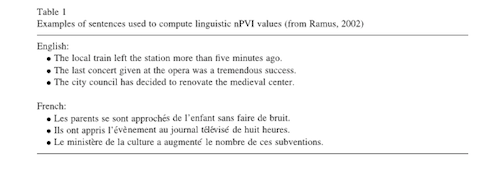
music, 2003
Each sentence contained about 15 syllables, and the duration of each of those syllables was compared, one by one, with the durations of all the other syllables within that particular sentence. This gave the researchers a measurement of how variable the syllable durations were in that sentence.
The formula used to make these comparisons, and so come up with the variability reading, is called the “normalized Pairwise Variability Index” (nPVI) – “pairwise” because the syllable durations are compared one against another (in pairs), “normalised” because the durational difference between each pair of syllables is measured relative to the average duration of the pair (hence making the readings independent of tempo), and “variability index” because that is the reading the formula comes up with.
Experiment 2 – musical scores
The analysis was repeated using musical scores instead of speech. All musical examples were by composers – native speakers of British English or French, living and working in England or France – writing in the late 19th/early 20th century (an era noted for musical nationalism). To focus the investigation on the abstraction of language into music, vocal pieces were excluded, as was music with an “external rhythmic agenda” or a “special style” that might force the composer to ignore his ‘own voice’. Just as the spoken sentences contained at least 12 syllables, so too the musical excerpts had at least twelve notes (and no fermatas or grace notes). The following pieces were thereby chosen:
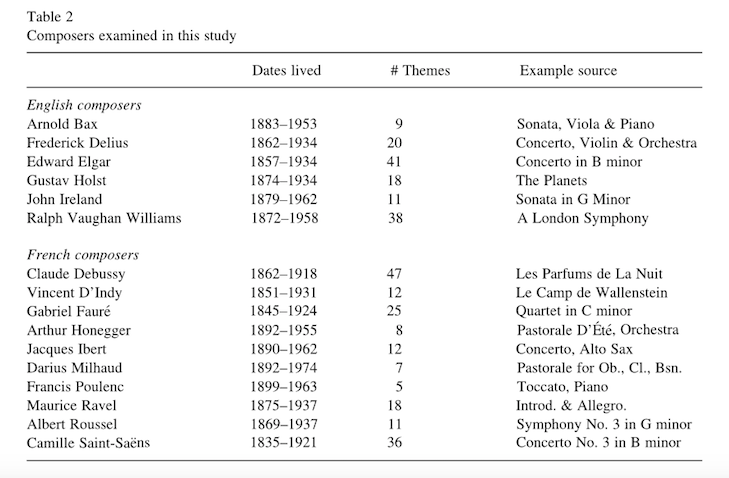
music, 2003
The formula – nPVI – used on the spoken sentences was also used on these musical excerpts, this time to investigate the variability of note lengths (seen as equivalent to syllable durations in speech), such that a tune composed entirely of crotchets would have no variability, a tune of ever-changing crotchets, quavers, dotted quavers etc would have high variability.
Results
The results from the speech analysis and the musical analysis both revealed strong national characteristics – English speakers/composers exhibited high variability in their syllable duration/note duration, while French speakers/composers had lower variability in theirs:
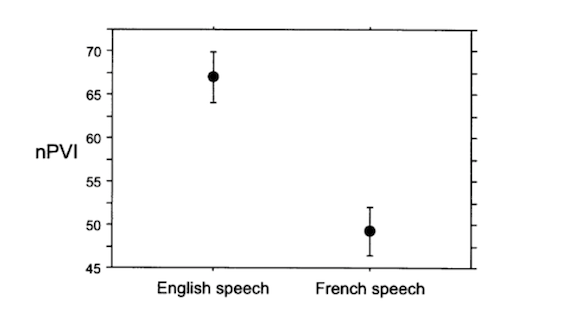
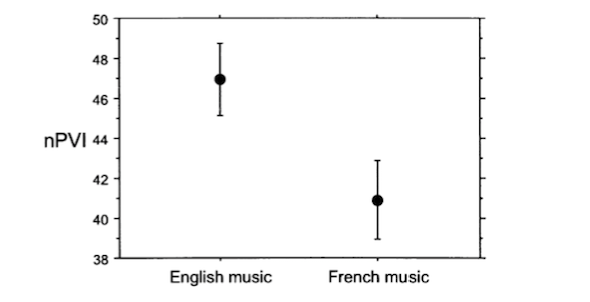
The researchers carried out a statistical check to confirm the study wasn’t biased by musical metre (whether compositions were 2-time, 3-time etc), confirming the effect was indeed independent of metre. Different composers exhibited this tendency to different degrees (see chart below), but the overall finding – that a composer’s nationality predicts the prosody of his music, just as a speaker’s nationality predicts the prosody of his/her speech – was strong. In the words of the authors: “There is a good deal of overlap between the English and French composers in terms of nPVI values, but on average a robust difference emerges, a difference which is in the same direction as the difference in linguistic nPVI values.”
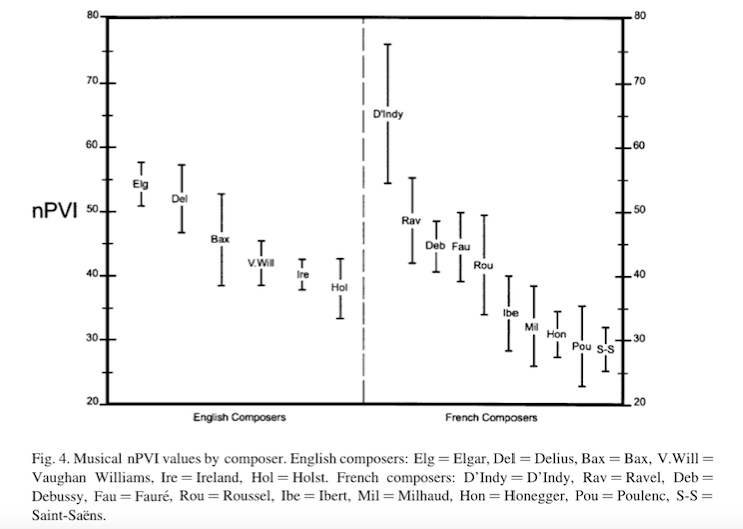
Discussion
The authors relate genuine surprise in finding such a significant effect of nationality on musical prosody, noting that “Music is an artistic endeavour with substantial intracultural stylistic variation and no a priori reason to follow particular rhythmic norms (unlike language). What is remarkable is that in the face of this diversity, average differences still emerge between cultures which parallel the rhythmic differences between the native languages of those cultures.”
They draw the conclusion that a linguistic pattern of rhythm is “in a composer’s ears”, and in those of their teachers, so inevitably makes its way into their musical compositions.
Especially interesting is their take on an outlier, the composer Vincent D’Indy. The variability of note lengths in the excerpts from this French composer’s music was unusually high, even compared to his English counterparts. The explanation on offer relates to his background, with the authors noting that D’Indy considered French 19th century music to be “superficial, frivolous and unworthy to compete with the teutonic Bach–Beethoven–Wagner tradition. …the serious and uncompromising principles of German symphony and of Bayreuth should be applied to French music, inspired by French legends and true to the spirit of French folklore.”
The adroit conclusion being that D’Indy may be “an exception that proves the rule rather than a mere outlier.”
Coda
Violin Concerto no. 3 in B minor, op61 – Saint-Saëns
Solo violin – Nathan Milstein, with Philharmonia Orchestra (live recording 1963)
Very interesting. Explains why it is usually easy to assign the correct national origin to an un-named piece heard for the first time.